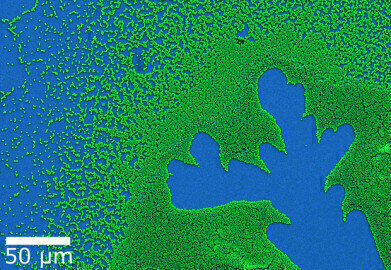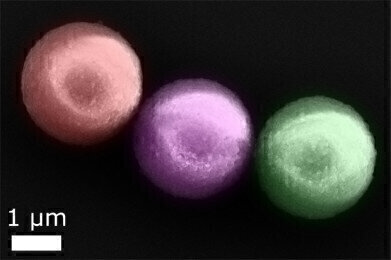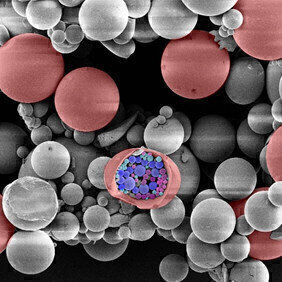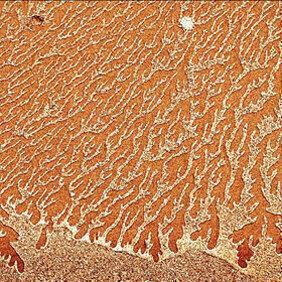-
 Héctor's winning image, magnetic particles deposited from an aqueous solution (false colour)
Héctor's winning image, magnetic particles deposited from an aqueous solution (false colour) -
 A close-up of three magnetic particles (false colour)
A close-up of three magnetic particles (false colour) -
 A glimpse inside a magnetic particle (false colour)
A glimpse inside a magnetic particle (false colour) -
 Trails of magnetic particles left behind after wet deposition (false colour)
Trails of magnetic particles left behind after wet deposition (false colour)
News & Views
nanoART image contest won by Héctor Corte-Leon
Feb 23 2016
The Fondation Nanosciences in France runs a monthly competition to pick the best images produced by nanotechnology research. Héctor Corte-Leon, a PhD student studying jointly at the National Physical Laboratory (NPL) and Royal Holloway, University of London, won the December 2015 competition for an image of a deposition pattern of magnetic particles.
The winning image is a false colour picture of the pattern that magnetic particles (shown in green) formed, after they were deposited from an aqueous solution onto a solid substrate and shows their different levels of aggregation. Héctor, a member of the Quantum Detection Group in NPL’s Quantum Metrology Institute, works on nanomagnetism and is researching magnetic nanosensors capable of detecting single particles/molecules for life science applications, for which single magnetic particles must be isolated.
Magnetic particles are unimaginably small. On the winning image the particles are 1 μm in diameter, and Héctor works with particles as small as 0.1 μm (human hairs can be 100 μm thick). In addition to their tiny size, the coating of the particles causes them to unhelpfully clump together. For biosensing applications it is essential to separate the particles and Héctor has been trialling different methods of wet casting to identify the ones that best isolate individual magnetic particles.
Once isolated, a single particle is attached to the tip of an atomic force microscope probe and used to study how particles interact with magnetic nanostructures, in order to test and compare the sensitivity of different nanosensors. The ultimate goal of the research is to develop magnetic nanostructures on silicon chips that can be used to identify small concentrations of specific molecules. Particles can be attached to other molecules, like proteins and so could be used by the chips to diagnose health conditions based on the proteins that particles capture in a sample (lab-on-a-chip biomedical applications).
The team's project is a collaboration between NPL, PTB in Germany, INRAM in Italy and a number of universities and institutions including, Royal Holloway, University of Surrey, Institut Neel and the University of Cambridge,
Engaging with Art
The nanoART competition is run partly to celebrate the work of early career scientists, but also to promote public engagement with nanoscience. In his exploration of the nano kingdom, Héctor and other NPL scientists in the Quantum Detection Group, routinely produce a range of astonishing images that offer a glimpse into a world that few of us ever have the chance to see.
These images have been produced using electron microscopes, as the beads are too small to be seen with conventional, light-based microscopes. False colours are added to the black and white images to make details stand out. The images are unworldly, while at the same time reminiscent of much larger scale subjects, like landscapes and planets.
The striking images produced by Héctor and his colleagues engender a sense of wonder that can hardly fail to enthuse both scientists and non-scientists alike and are an engaging way to develop public awareness and interest in nanoscience.
Digital Edition
Lab Asia 31.2 April 2024
April 2024
In This Edition Chromatography Articles - Approaches to troubleshooting an SPE method for the analysis of oligonucleotides (pt i) - High-precision liquid flow processes demand full fluidic c...
View all digital editions
Events
Apr 22 2024 Marrakech, Morroco
Making Pharmaceuticals Exhibition & Conference
Apr 23 2024 Coventry, UK
Apr 23 2024 Kintex, South Korea
Apr 23 2024 Seoul, South Korea
Apr 24 2024 Jakarta, Indonesia












.jpg)




